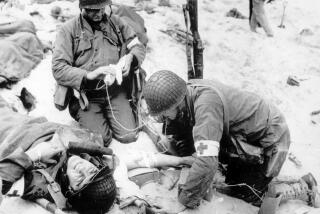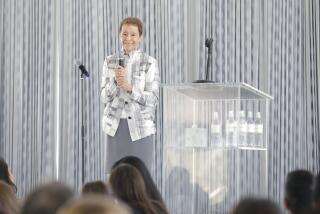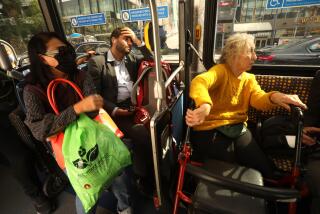Wound Care Center Pioneers Technique : Van Nuys: The facility uses growth factors from patients’ own blood to create a topical solution that heals even diabetics’ stubborn infections.
- Share via
When Elizabeth O’Brien developed a blister three years ago while attending a nephew’s wedding, she had little reason to suspect that it might cost her a foot.
The 57-year-old marine biologist and onetime deep-sea diver from North Hollywood had always managed to nurse her wounds successfully before, even though being a diabetic made the recovery a much more protracted and painful affair.
This time, though, the blister festered and infection set in, swelling her foot to twice its normal size. “It will never heal,” said one doctor she is still so angry with she won’t repeat his name. “We’d better get your foot off.”
Today, however, she is pain-free and as attached to her foot as ever.
O’Brien is one of more than 75 patients who have sought relief and healing for nasty wounds since the Valley Wound Care Center opened in November. Located at Valley Hospital Medical Center in Van Nuys, the facility is the only one of its kind in the San Fernando Valley and one of only four in Southern California.
The seven specialists who work at the center are able to heal wounds others cannot by employing a technique in which the patient’s blood is used to promote the growth and restoration of tissue.
The process was developed seven years ago by David Knighton, a doctor at the University of Minnesota. Mark Greenstadt, medical director of the wound center, said Knighton wanted to improve treatment for “a group of chronic, non-healing ulcers.”
Many of these ulcerous wounds develop in diabetics, who make up half the patients at the Van Nuys center.
According to Greenstadt, Knighton came up with a “laundry list” of treatments for such wounds, ranging from cleaning out deep infections to caring for the wound without applying pressure to it.
Knighton also found that the normal healing process releases a set of hormones into the area of the wound.
This process does not work efficiently in diabetics because the disease affects the circulatory system and blocks healing elements in the blood from reaching the wound in sufficient quantities to speed the recovery process.
After some time, Knighton isolated those elements in the blood that promote healing, which came to be called growth factors. Greenstadt said there are at least five, and each does its job in a slightly different way, although all work in tandem.
When a patient is deemed suitable for treatment at the wound center, a quantity of his or her blood is removed and spun in a centrifuge to break the growth factors out of the blood. These are then treated chemically to produce a topical solution called procuren. Tubes of procuren are given to the patient to apply directly to the wound, bypassing the inefficient circulatory system in the diabetic’s body.
Nationally, the success rate of procuren treatments in healing these difficult wounds is about 86%.
Linda Swanson, wound center program director, said the facility is too new to have reliable cure-rate figures. She said that based on early results, the rate locally will be in the same range as the national figures.
Cost of the treatment ranges from $10,000 to $15,000, and 80% of the fees are covered by insurance. Most of the clientele is local, though some patients have come from as far away as Las Vegas.
Pauline Bassoff, a 66-year-old former Angeleno who moved to Las Vegas three years ago, heard about the Van Nuys center only days before she was scheduled to have her leg amputated.
In July, while she stood outside the Mirage in Las Vegas admiring the hotel’s artificial rain forest, a tourist searching for the best camera angle stepped on her foot. Bassoff suffers from peripheral vascular disease, which constricts the flow of blood to her feet, and a wound that would not heel developed on her foot.
Several months later, Bassoff was in so much pain that she had to stay in bed. She took a variety of drugs to control the pain, but nothing worked.
“The only alternative they gave me,” she said of her doctors in Las Vegas, “was amputation of the leg to the knee.” Six days before the planned surgery, scheduled Jan. 12, Bassoff’s daughter heard a radio advertisement for the wound center in Van Nuys.
A few days later, Bassoff, in a wheelchair, boarded a plane for Los Angeles. After seven weeks of procuren treatments, the wound was healed. “I’m a walking miracle,” she said.
Miracle is the same word O’Brien uses to describe her recovery. When one doctor advised amputating her foot, she walked out of his office determined to live with her pain. Then she heard about the wound center. She came to an open house in January and returned for a consultation on Feb. 13 with Dr. John Halebian.
“No problem; it can be cured,” he told her after looking over the nasty wound that had spread across the bottom of her foot.
A week later, she was in surgery. When she emerged, her first question to the doctor was how long would it take for the anesthetic to wear off and the pain to return. The pain had been so constant for two years, its absence seemed like a loss. “Heck, I missed the pain,” she said. It never returned.
She applied procuren twice a day and changed dressings regularly. In eight weeks, the wound was gone, and she is out jogging once again.
Her diabetes prevents her from diving anymore. But the cure of her foot has allowed O’Brien to return to the lecture circuit to talk about marine biology.






